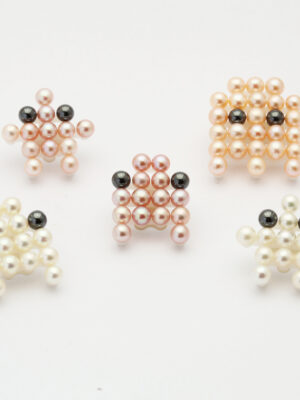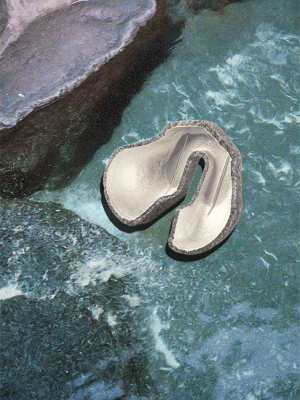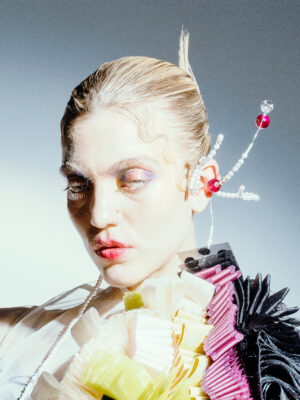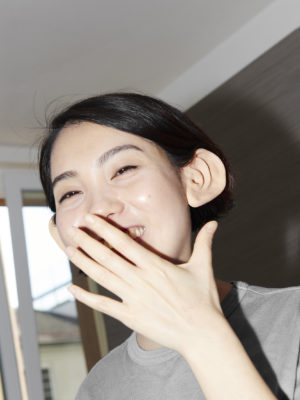MELANIE HOLCOMB is a Curator in the Department of Medieval Art and The Cloisters at the Metropolitan Museum of Art, where she is a specialist in the luxury arts of the Middle Ages. Dr. Holcomb is currently leading a team of six curators in the development of this cross-cultural exhibition of jewelry:
I think of the show as a celebration and an investigation of jewelry: what it is, why we wear it, why we have always worn it. There are two main and intersecting points we make in the exhibition. The first is that we define jewelry as precious objects for the body—a setting like no other for the display of art. The second is that we make the case that jewelry does something to us when we wear it. It’s active, it has agency, it transforms us. So through the course of the show we see again and again the ways in which jewelry activates the body it adorns.
In the first room we lay the foundational notion of jewelry as art for the body: you walk into a spectacular space with rows upon rows of column-shaped cases, each containing a single piece of jewelry. As an ensemble, they offer an abstracted map of the body that starts from the feet and the ankles and moves to the waist and all the way up to the head. And as you take in this grand formation of cases, you are granted a dramatic cross-cultural view of jewelry, a subliminal reminder that there is no culture anywhere or anytime that does not produce jewelry. The rest of the show dives into specific cultural moments, traversing time and place to look more deeply at how jewelry functions. But that room is where you begin and that’s where you end, so everything else stems from that central notion of jewelry only making sense in relationship to the human form.
One point of pride with this show is that The Met is taking advantage of its extraordinary collection that spans the globe and most of human history; we have 17 curatorial departments, and it turns out when the topic is jewelry, there’s not one department that can’t contribute something interesting—even Musical Instruments! So, again you get a sense of the sweep of the exhibition. There is a team of curators, six of us working together. And we all come from different departments and different areas of expertise.
“On the streets of New York we don’t see so many nose rings that cover half the face.”
When I look at the kinds of jewelry that young people wear today, I’m struck by the way in which a lot of the forms—whether we are talking about gauged earrings, nose jewelry, lip jewelry—are among the oldest that jewelry takes. And in the ancient world, jewelry is imbued with some of the deepest meaning. I suspect most wearers of jewelry today have no idea that some of the most contemporary, even edgiest kinds of jewelry have such deep roots. I think it’s part of our global sensibility, the access we now have to the different forms jewelry has taken, that has made this possible. I also think some contemporary jewelry-makers look to the ancient world for inspiration precisely because these pieces often make such a bold statement. Of course there are striking examples of ancient jewelry that haven’t made a comeback—on the streets of New York we don’t see so many nose rings that cover half the face, for instance. I suppose they are too impractical or perhaps they just haven’t found the right jeweler to reinterpret them for a modern audience—but maybe they should!
JOANNE PILLSBURY is the Andrall E. Pearson Curator at The Metropolitan Museum of Art, specializing in the art and archaeology of the ancient Americas:
Jewelry, in all times and all places, is about prompting a strong response, both perceptually and conceptually; through time and through place this is something that jewelry holds in common.
MELANIE HOLCOMB One of the reasons the exhibition goes back and forth across time is to demonstrate that there are abiding ideas when it comes to jewelry.
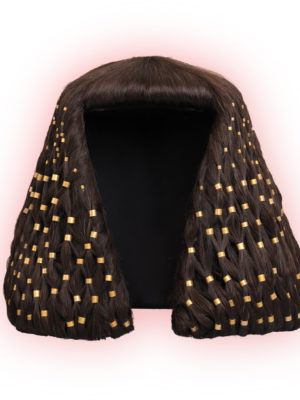
DIANA CRAIG PATCH is the Lila Acheson Wallace Curator in Charge of the Department of Egyptian Art at the Metropolitan Museum of Art:
Isn’t the idea of glittering hair jewelry terrific? Several hundred gold rings decorated one of the wigs buried with a princess from ancient Egypt. The hair decomposed but the rings survived. Here we’ve placed them on a modern wig in a cascading pattern suggested by surviving depictions.
KIM BENZEL is Curator in Charge of the Department of Ancient Near Eastern Art at the Metropolitan Museum of Art:
Yes. In ancient Mesopotamia, the idea of gold in the hair and around the face was to give a golden shine to the head area. This fits into a millennia-long tradition and could plausibly be related to the halo, which appears later in Christianity.
“It’s like a Birkin handbag, just ridiculously high-end.”
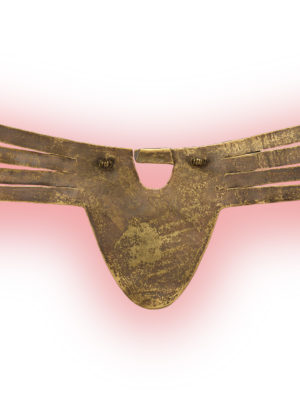
JOANNE PILLSBURY This a really great piece because it is about transformation and the ideas associated with that. It would attach to the septum of the nose. And it would cover much of the mouth, it would actually cover much of the face. And it elevates the wearer above the realm of the mundane. It associated the wearer with powerful aspects of the great cats of South America—pumas, jaguars, and so forth. Those great cats are exceptional because they move between realms, they can swim, they can climb into trees, so they’re creatures that can cross boundaries in a wonderful way.
This piece is from south-western Colombia, an area where as far as we know, gold was something that was really limited to the indigenous leaders of the region. It was a material that was associated with the highest level of political and ritual authority, and the material itself was considered to be divine. Gold is literally incorruptible, it doesn’t decay, it doesn’t tarnish. So it speaks to a whole series of ideas about eternal life, it speaks about the power of the sun.
In the early twentieth century we know that Kogi ritual specialists would leave their gold ornaments out in the sun to recharge and repower. So this is a work that is rich in meaning and can be really seen as a springboard for a whole sweep of ideas.
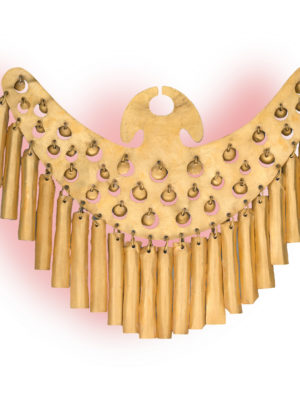
JOANNE PILLSBURY They loved nose ornaments in ancient South America, and those ornaments—some people call them “mouth masks” because they actually obscure the mouth. Whereas when you go further north into ancient Mexico they actually wear a lot of lip jewelry, and it celebrates the mouth. So there’s this interesting interplay of revealing and concealing these parts of the body.
These small elements would have moved, captured the light and reflected the light, and again, making them seem as if they were alive. They also would have knocked against each other and made a lovely delicate tinkling sound, so you would hear the ruler as much as you would see the ruler. So it speaks to this idea of activating the body in performance.
Why does it cover the mouth? I would like to say we have a good answer as to why, but we really don’t know. I think it may be about transformation and making the wearer into a divine being. To cover the mouth, it could have a protective element. It’s protecting that terribly important opening to the body, but it’s also obscuring the generator of sound, making the voice of the wearer into a voice of the gods, a supernatural sound.
“It would have created an extraordinary image if you had faced the wearer on the battlefield or in a ceremony that that tongue could go in and out.”
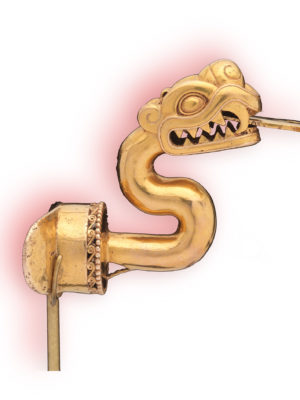
JOANNE PILLSBURY This lip ornament is one of the greatest works of body ornamentation known from the ancient Americas. It’s wonderfully distinct from those nose ornaments because this is a snake. The serpent would have been inserted through a perforation in the lower lip and the flange would have rested against the gum of the lower jaw. Living in New York City, I see a lot of people wearing lip jewelry now and I look at them and I’m sort of like, “That’s nice, but you’ve got a long way to go!”
For us now, we think lip jewelry is decorative or perhaps a little bit rebellious, but for the Aztecs it was very appropriate to ornament the mouth because the Aztecs considered the mouth to be the location of power. The Aztecs referred to their political leaders as the Huēyi tlahtoāni or “the great speaker,” and they appreciated political leaders who could speak with beauty, with precision, and with truth. We’ve often joked saying, maybe this is a tradition we should bring back in our day and age! This is really a wonderful object in itself. Gold-working actually came relatively late to Mexico, it only entered into Mexico after about a 1000 AD, so several thousand years after it was used in South America, but they adopted it quickly and did brilliant things with it. And it’s an extraordinary gold casting, the serpent’s tongue could move in and out, and side to side.
It would have created an extraordinary image if you had faced the wearer on the battlefield or in a ceremony that that tongue that could go in and out. But as with South America, the Aztecs considered gold to be a sacred material. They considered it to be part of the sun, they actually considered it, I think the polite term is “night soil,” of the sun, when it went through its revolution, and it was deposited in the earth. It would be the sacred material of the earth but also closely associated with the sun.
MELANIE HOLCOMB Joanne is so articulate in talking about the power of gold. Though the exhibition showcases many materials, gold is something of a leitmotif throughout. We see repeatedly how it’s associated with the gods and therefore anyone who wants to associate themselves with the gods or immortality, precisely because of its incorruptibility. It also has this important property of infinite malleability, which allows it to be reformed again and again. It’s thus a fascinating material that is both permanent and changeable.
JOANNE PILLSBURY And what’s so interesting, as Melanie was saying, [is that] it’s one of the most reusable of metals and so when we look at some of the colonial or later European works in gold, you look at them and you wonder, Did that have an earlier life as a pre-Colombian ornament that was melted down? These things were remade for new gods and new kings, so gold really has this wonderful, transformative characteristic in itself.
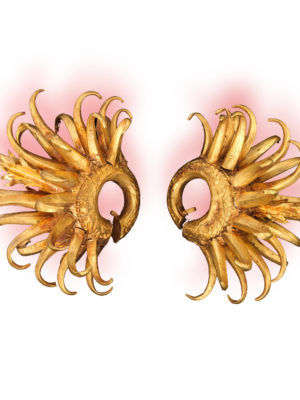
MELANIE HOLCOMB These are beautiful pieces. They are Javanese and thus belong to a rich tradition of gold jewelry-making from Indonesia. I think of chrysanthemums when I see them. And they are sizeable—real statement pieces—3 inches at their greatest width. They draw attention to the ear and thus the face.
One thing that is so interesting to me in putting together this exhibition is the enduring aesthetic of large or extended earlobes. We see it these days in the phenomenon of ear flares or the gauged ear, but it is a cross-cultural phenomenon thus cuts through time. If, for example, you spend time looking at statues of deities within various Asian traditions—Chinese, Tibetan, Indian and more—you can’t help but notice the enlarged earlobes that support dramatically large earrings. The discreet stud is not what we’re going for! Large earrings are linked to both divinity and royalty. And the Buddha is noteworthy for his extended earlobes with no earrings in them. It is a reminder that he was once a prince, but has now discarded those trappings.
“The discreet stud is not what we’re going for! Large earrings are linked to both divinity and royalty.”
MELANIE HOLCOMB Going back to the idea of earrings as framing the face, I think so much jewelry is concentrated around the face because that is where we find a concentration of our sense organs. In Mayan culture, the ears are particularly important as an orifice that takes you into the body. In medieval Europe, inspiration comes from the Holy Spirit whispering into your ear. The earlobes are also parts of the body that can be stretched and changed without causing harm, so there is a fascinating interaction between the properties of the body and the form that jewelry takes.
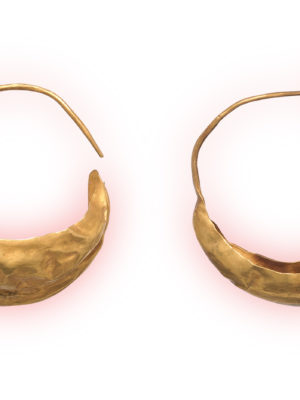
KIM BENZEL Aren’t these gigantic hoops amazing? They are the oldest pieces of jewelry in the show and yet, of course, the most contemporary. They belonged to a full set of jewelry that framed the face. The ensemble would have included a hair comb, headdress, hammered gold ribbons for the hair, as well as several necklaces, [and] a pin. This jewelry comes from the so-called Royal Cemetery of Ur, a vast cultic burial site of some two thousand graves. This is not a standard graveyard, but something more akin to a majestic piece of theatre, replete with weapons, oxen, chariots, musical instruments, and a vast supporting cast of guards, musicians, and attendants. This jewelry ensemble would have been worn by one of the attendants. We don’t really know who the star of this theatrical display was but we assume he or she was a royal figure or priest or priestess or both. Jewelry was crucial to the whole performance. The big question is who, if anyone, actually saw it?
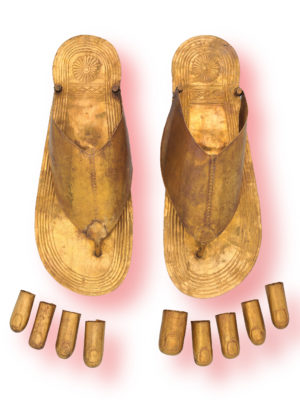
DIANA CRAIG PATCH To begin with, sandals were only worn by the elite. Make them gold and we are operating in the realm of royalty. It’s like a Birkin handbag, just ridiculously high-end. These were components of ensemble worn in death. Jewelry was part of the equipment that girded you as you moved through the afterlife, because it was a dangerous journey. Toes and your fingers are among the most vulnerable extremities, so they too needed protection. It was crucial that the body remained intact. When you die, nails rapidly dry and fall off: finger- and toe-stalls kept the nails in place and therefore maintained the integrity of the body. If you were not royal, you would have to use string to keep the nails in place. I should add that I don’t think we’re missing a toe, we’re just missing a toe-stall.
MELANIE HOLCOMB I think we should revive the idea of gold toe-stalls. Forget nail polish—that’s so yesterday! The golden flip-flops, as I like to call them, are among the stars of the show. Actually, we have two pairs in the exhibition, because they are so spectacular. One pair is among the first objects you encounter, in that first great “body space.” Another set appears again later, where you see them in the context of a full ensemble of burial wear for a royal wife. The museum is lucky to have multiple examples of the gold sandals, because there were three royal wives buried together and each had her own set.
DIANA CRAIG PATCH Yes. That full ensemble includes a set of finger- and toe-stalls along with a broad collar, an armband, a scarab heart amulet, an amulet for the abdomen, and the gold sandals.
MELANIE HOLCOMB One last point I would want to make is that I am convinced that the ancient jewelry in the exhibition will provide some of the freshest sources of inspiration for contemporary jewelry wearers and jewelry makers. They present a clean and powerful aesthetic that speaks in so many ways to a modern sensibility. The oldest pieces I find [to be] among the most radical and show-stopping of all.
JEWELRY: THE BODY TRANSFORMED
Nov. 12. 2018—Feb. 24. 2019
www.metmuseum.org
This article was first published in the #6 Current Obsession Paper for New York City Jewelry Week
